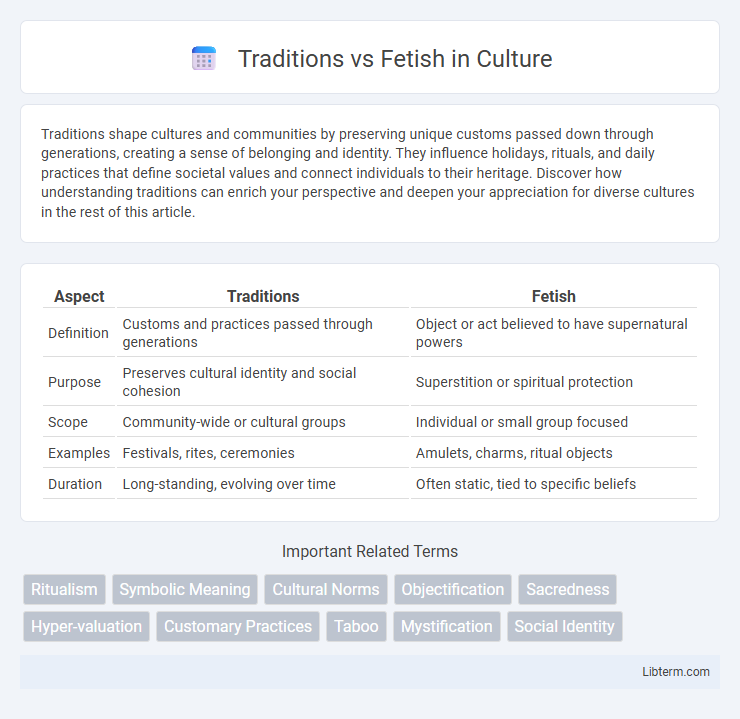Traditions shape cultures and communities by preserving unique customs passed down through generations, creating a sense of belonging and identity. They influence holidays, rituals, and daily practices that define societal values and connect individuals to their heritage. Discover how understanding traditions can enrich your perspective and deepen your appreciation for diverse cultures in the rest of this article.
Table of Comparison
| Aspect | Traditions | Fetish |
|---|---|---|
| Definition | Customs and practices passed through generations | Object or act believed to have supernatural powers |
| Purpose | Preserves cultural identity and social cohesion | Superstition or spiritual protection |
| Scope | Community-wide or cultural groups | Individual or small group focused |
| Examples | Festivals, rites, ceremonies | Amulets, charms, ritual objects |
| Duration | Long-standing, evolving over time | Often static, tied to specific beliefs |
Understanding Traditions: Meaning and Purpose
Traditions represent cultural practices passed down through generations, serving as a means to preserve identity, values, and social cohesion within communities. Their purpose lies in fostering a shared sense of belonging and continuity by connecting individuals to their heritage and collective history. Understanding traditions involves recognizing their symbolic significance and the role they play in guiding behavior and reinforcing community bonds.
Defining Fetish: Origins and Concepts
Fetish originates from the Portuguese word "feitico," meaning charm or sorcery, reflecting objects believed to possess supernatural powers in various cultures. In anthropology, a fetish is defined as an inanimate object revered for its supposed magical or spiritual attributes, often used in rituals or as protective talismans. This concept contrasts with traditions, which encompass broader cultural practices and beliefs passed down through generations without necessarily attributing inherent mystical power to specific objects.
Cultural Significance: Traditions in Society
Traditions serve as the foundational cultural practices that preserve collective identity and social cohesion across generations, reinforcing shared values and community continuity. They embody historical narratives and rituals that foster intergenerational bonds and provide a sense of belonging, often deeply embedded within societal customs and belief systems. Unlike fetishes, which typically denote objects imbued with supernatural power or obsession, traditions are culturally constructed systems that sustain societal norms and collective memory.
Psychological Foundations of Fetishism
Psychological foundations of fetishism involve unconscious associations formed during early developmental stages, where specific objects or body parts become linked to sexual arousal as a coping mechanism or source of comfort. Unlike cultural traditions that are socially transmitted practices or rituals, fetishes arise from individual psychosexual experiences and fixation patterns deeply rooted in the unconscious mind. Neuroscientific studies highlight altered neural activations in limbic system regions, supporting the view that fetishism is anchored in distinct emotional and reward processing pathways.
Rituals and Practices: Where Traditions and Fetish Intersect
Rituals and practices in both traditions and fetish often involve symbolic actions performed regularly to evoke specific meanings or desired outcomes. Traditions embed rituals within cultural or religious frameworks, while fetish practices emphasize personal or group focus on objects or sensations for emotional or spiritual significance. The intersection occurs where communal ceremonies adopt fetishistic elements, creating hybrid rituals that blend collective meaning with intense, focused symbolism.
Social Acceptance: Tradition vs. Fetish
Traditions often enjoy widespread social acceptance due to their deep cultural roots and community endorsement, solidifying a sense of identity and continuity across generations. Fetishes, conversely, typically face social stigmatization as they deviate from normative practices and lack broad cultural validation. This divergence in social acceptance highlights how traditions reinforce communal bonds while fetishes remain marginalized or misunderstood within mainstream society.
Evolution and Transformation Over Time
Traditions evolve through cultural transmission, adapting rituals and practices across generations to maintain social cohesion and identity. Fetishes, originally objects believed to possess supernatural powers, transform as their symbolic meanings shift in response to changing belief systems and external influences. Both concepts reflect dynamic processes where significance is continuously reinterpreted, illustrating the fluid nature of cultural and spiritual phenomena over time.
Controversies and Misconceptions
Traditions often face controversy when they intersect with fetishes, as cultural practices may be misinterpreted or sensationalized, leading to stigma and misunderstanding. Misconceptions arise when traditional rituals are exoticized or reduced solely to fetishistic elements, undermining their cultural significance and authenticity. Clear distinctions are essential to respect cultural heritage and avoid perpetuating harmful stereotypes or cultural appropriation.
Impact on Identity and Community
Traditions reinforce collective identity by fostering shared values, rituals, and cultural continuity that bind communities together over generations. Fetishes, often centered around individual object veneration and symbolic power, can fragment communal cohesion by prioritizing personal beliefs over collective norms. The tension between traditions and fetishes highlights the balance between communal belonging and individual expression in shaping social identity.
Navigating Boundaries: Respect and Sensitivity
Navigating boundaries between traditions and fetishes requires a nuanced understanding of cultural context and personal consent. Respect and sensitivity are essential to honor the origins and meanings of traditional practices while avoiding appropriation or objectification. Open communication and education foster awareness, ensuring all parties feel valued and safe.
Traditions Infographic

 libterm.com
libterm.com